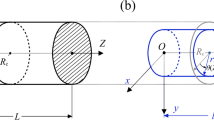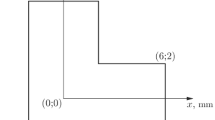Abstract
The problems of free and constrained torsion of a rod of solid circular cross-section are solved numerically using a tensor linear constitutive relation written in terms of the energy compatible Cauchy stress and Hencky logarithmic strain tensors. The only function used to determine the properties of the isotropic incompressible material of the rod is a power-law function that approximates the shear diagram and corresponds to an elastoplastic material with power-law hardening. The solution obtained shows that, despite the tensorial linearity of the state law, the use of the logarithmic strain measure allows one to describe qualitatively the effect of significant elongation of the rod in free torsion (the Poynting effect) as well as the arising normal longitudinal, radial, and circumferential stresses, whose values are commensurable, at large deformations, with the maximum tangential stresses in the cross-section. Computational dependences of the torsional moment on the angle of twist in free and constrained torsion are obtained. These dependences are found to be significantly different from each other; the limitmoment and the correspondingmaximum angle of twist for free torsion are found to be considerably lower than those for constrained torsion. It follows that the shear strength, which is traditionally calculated from the maximum torsional moment, becomes indeterminate. For constrained torsion, the dependence of the longitudinal compressive force on the angle of twist is obtained.
Summing up and generalizing the computational results, one can conclude that using the logarithmic strain measure as well as the material shear diagram and the corresponding tensor linear constitutive relation allows one to describe, at large deformations, effects that usually require applying different tensor nonlinear constitutive relations of nonlinear elasticity, including elastic constants of the second and third orders.
Similar content being viewed by others
References
A. Nadai, Theory of Flow and Fracture of Solids, Vols. 1 and 2 (McGraw-Hill, New York, 1950, 1963; Mir, Moscow, 1963, 1969).
R. Hill, TheMathematical Theory of Plasticity (Oxford Univ. Press, Oxford, 1950; Gostekhizdat, Moscow, 1956).
A. D. Panov, “Nonlinear Effects in Axially Symmetric Deformation of a Cylinder. Poynting Effect,” Izv. Akad. Nauk. Mekh. Tverd. Tela, No. 5, 27–43 (2004) [Mech. Solids (Engl. Transl.) 39 (5), 21–34 (2004)].
A. D. Panov, “Specific Features of Determining the Shear Diagram of a Material at Finite Strains,” in Scientific and Engineering Problems in Reliability and Durability of Structures and Methods of their Solution. Proc. 5th Intern. Conf. (Izd-vo St. Petersburg Univ, St. Petersburg, 2003), pp. 400–407 [in Russian].
D. V. Georgievskii, “Tensor Nonlinear Effects in Isothermal Deformation of Continuous Media,” Uspekhi Mekh. 1(2), 150–176 (2002).
A. I. Lurie, Nonlinear Theory of Elasticity (Nauka, Moscow, 1980) [in Russian].
A. D. Panov, “Theory of Constitutive Relations for Isotropic Solids,” Izv. Akad. Nauk. Mekh. Tverd. Tela, No. 6, 27–44 (2004) [Mech. Solids (Engl. Transl.) 39 (6), 20–32 (2004)].
A.D. Panov, “Variation in the Length of Perfectly Elastic Rods under Torsion,” Izv. Akad. Nauk. Mekh. Tverd. Tela, No. 2, 71–78 (2008) [Mech. Solids (Engl. Transl.) 43 (2), 225–231 (2008)].
A. D. Panov, Theory of Deformation of an Isotropic Solid at Finite Strains (A New Method for Determining the State Law) (Izd. MGTA im. Kosygina, Moscow, 1998) [in Russian].
K. K. Likharev, “Comparison ofMaterial Characteristics in Uniaxial Tension and Compression,” in Strength Analysis in Mechanical Engineering, No. 89 (Izdat. MVTU, Moscow, 1958), pp. 168–196 [in Russian].
A. D. Panov, “Specific Characteristics of Determining the Limit State in Structural Elements Made ofHighly Plastic Materials,” Proc. 4th V. A. Likhachev Intern. Seminar “Topical Strength Problems” (Novgorod, 2000), Vol. 1, pp. 148–153 [in Russian].
V. I. Agal’tsov, S. A. Vladimirov, and V. P. Degtyarev, “Mathematical Modeling of Mechanical Properties of Metals and Alloys at Large Strains” Izv. Akad. Nauk. Mekh. Tverd. Tela, No. 1, 145–159 (2007) [Mech. Solids (Engl. Transl.) 42 (1), 123–134 (2007)].
Author information
Authors and Affiliations
Corresponding author
Additional information
Original Russian Text © A.D. Panov, V.V. Shumaev, 2012, published in Izvestiya Akademii Nauk. Mekhanika Tverdogo Tela, 2012, No. 1, pp. 92–100.
About this article
Cite this article
Panov, A.D., Shumaev, V.V. Using the logarithmic strain measure for solving torsion problems. Mech. Solids 47, 71–78 (2012). https://doi.org/10.3103/S0025654412010062
Received:
Published:
Issue Date:
DOI: https://doi.org/10.3103/S0025654412010062




